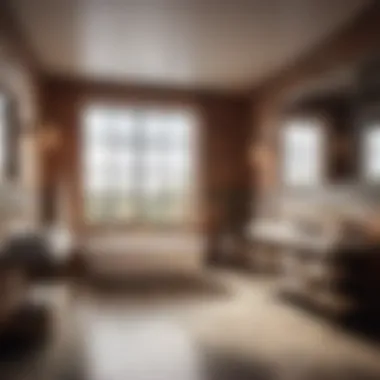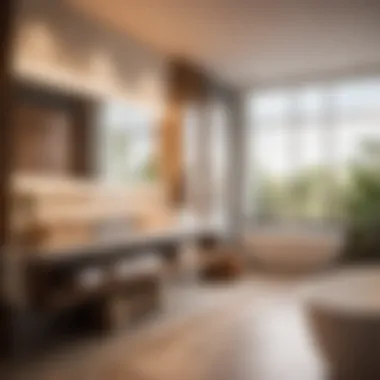The Ultimate Guide to Bathroom Retiling: How Long Does It Take?


Materials:
To begin the retiling process, gather the following materials in exact measurements:
- Ceramic or porcelain tiles: Ensure you have enough to cover the entire bathroom floor or walls, accounting for extra tiles for cuts and breakages.
- Tile adhesive: Choose a waterproof adhesive suitable for the type of tiles you are using.
- Grout: Select a color that complements your tiles and is appropriate for wet areas.
- Tile spacers: These will help you maintain consistent spacing between tiles for a professional finish.
- Notched trowel: Essential for spreading adhesive evenly on the surface before laying the tiles.
- Tile cutter: For precise cuts when fitting tiles around edges and corners.
- Level: To ensure your tiles are laid flat and uniform.
- Sponge and bucket: For cleaning excess adhesive and grout during installation.
DIY Steps:
- Preparing the Surface: Start by removing any existing tiles or flooring and ensuring the surface is clean, smooth, and dry. Fill any cracks or holes and allow them to dry completely.
- Planning and Layout: Measure the area to be tiled and plan the layout to avoid small or awkward cuts. Start tiling from the center for symmetry.
- Applying Adhesive: Use a notched trowel to spread the adhesive evenly on the surface, working in small sections to prevent it from drying out.
- Laying Tiles: Press each tile firmly into the adhesive, using tile spacers to maintain even gaps between tiles. Continue this process until all tiles are in place.
- Grouting: Once the adhesive is dry, apply grout using a rubber float, pressing it into the gaps between tiles at a 45-degree angle. Wipe off excess grout with a damp sponge.
Technical Aspects:
- Tools: The essential tools include a trowel, tile cutter, level, sponge, and grout float.
- Timing specifics: Allow the adhesive to set for the recommended time before grouting, typically 24 hours.
- Critical techniques: Ensure tiles are correctly spaced, leveled, and grouted to achieve a professional finish.
DIY Project Process:
- Detailed Installation Method: Follow the step-by-step process outlined above, ensuring each tile is placed with precision and care.
- Highlighting Key Techniques and Timings: Pay attention to leveling, spacing, and grouting techniques to enhance the overall quality of the tiling project.
- Troubleshooting Tips: In case of mistakes or adjustments, use spare tiles for replacements and address any leveling issues promptly to maintain consistency.
This comprehensive guide provides housewives and house owners with a detailed overview of the retiling process, from materials and steps to technical aspects and troubleshooting tips, ensuring a successful DIY renovation project.
Understanding the Scope of Retiling
In this comprehensive guide on retiling a bathroom, Understanding the Scope of Retiling plays a crucial role in ensuring a successful renovation process. By delving deep into this topic, individuals gain clarity on the complexities involved in the retiling project, setting the foundation for efficient planning and execution. The assessment of current bathroom condition, design and tile selection, and gathering necessary tools and materials all stem from a thorough understanding of the scope of retiling. This initial step not only provides a roadmap for the entire project but also helps housewives and homeowners anticipate challenges and make informed decisions.
Assessment of Current Bathroom Condition
Evaluating existing tiles
Evaluating existing tiles is a pivotal aspect of assessing the current bathroom condition. This process involves inspecting the quality, condition, and suitability of the current tiles for the upcoming retiling project. By scrutinizing factors such as wear and tear, cracks, or outdated styles, homeowners can determine whether complete tile removal or partial replacement is necessary. The benefit of evaluating existing tiles lies in identifying areas that require attention, whether in terms of structural integrity or design aesthetics. Understanding the condition of the current tiles enables homeowners to plan effectively and allocate resources efficiently throughout the renovation process.
Identifying any structural issues
Identifying any structural issues is a critical step in the assessment of the current bathroom condition. It entails examining the underlying infrastructure, walls, and floors for any signs of damage, moisture retention, or weakness that could impact the retiling project. By uncovering structural issues such as water damage, mold growth, or compromised surfaces, homeowners can address these concerns before proceeding with the renovation. This proactive approach not only ensures a solid foundation for the new tiles but also prevents potential issues from escalating in the future. While identifying structural issues may prolong the planning phase, the long-term benefits of securing a stable base far outweigh any initial delays.


Design and Tile Selection
Choosing appropriate tiles
The selection of appropriate tiles is a crucial aspect of the design process that greatly influences the overall outcome of the retiling project. Choosing tiles that align with the homeowner's aesthetic preferences, budget constraints, and functional requirements is essential for creating a harmonious bathroom space. Factors such as material durability, water resistance, and ease of maintenance should also be considered when selecting tiles for high-traffic areas like bathrooms. The advantage of choosing appropriate tiles lies in achieving a balance between style and functionality, enhancing the visual appeal and longevity of the tiled surfaces.
Finalizing layout and pattern
Finalizing the layout and pattern of the tiles is a creative yet strategic decision-making process that shapes the visual impact of the renovated bathroom. Determining the tile arrangement, orientation, and design scheme can significantly transform the ambiance and perceived size of the space. By experimenting with different layouts and patterns, homeowners can personalize their bathroom according to their taste and spatial constraints. The unique feature of finalizing layout and pattern lies in the opportunity to showcase individual style preferences and create a cohesive design narrative throughout the room. While this stage may involve iteration and refinement, the end result is a custom-tailored bathroom aesthetic that reflects the homeowners' personal touch.
Gathering Necessary Tools and Materials
List of essential tools
Compiling a comprehensive list of essential tools is a fundamental component of the preparation phase that streamlines the retiling process. From tile cutters and spacers to trowels and grout floats, having the necessary equipment on hand facilitates efficient tile installation and ensures precision in the application. The key characteristic of a well-curated tool list lies in equipping homeowners with the means to tackle various tasks, from surface preparation to grout finishing. Investing in quality tools not only enhances the overall efficiency of the project but also contributes to the professional quality of the final results.
Quality of materials impact on time
The quality of materials used in the retiling project directly influences the timeline and overall durability of the installation. Opting for high-quality tiles, adhesives, and grouts can expedite the process by minimizing instances of breakage, misalignment, or discoloration during installation. Additionally, premium materials offer superior resistance to moisture, stains, and wear over time, reducing the need for frequent repairs or replacements. The unique feature of prioritizing material quality lies in ensuring a long-lasting and visually appealing finish that enhances the value of the bathroom space. While higher-quality materials may involve a greater initial investment, the time saved on future maintenance and replacements justifies the upfront cost.
Preparation Phase
In the grand scheme of retiling a bathroom, the preparation phase plays a paramount role in ensuring a successful renovation project. It sets the foundation for the entire process, emphasizing the importance of meticulous planning and organization. The preparation phase encompasses several key elements that need to be addressed before embarking on the actual tiling process. By investing time and effort in this initial stage, housewives and homeowners can streamline the subsequent steps, leading to a smoother and more efficient renovation journey.
Clearing the Bathroom Space
Removing Fixtures and Furniture
When it comes to retiling a bathroom, one of the crucial aspects of the preparation phase is clearing the space of fixtures and furniture. Removing existing fixtures such as sinks, toilets, and cabinets is essential to create a clean slate for the tiling process. This step allows for better access to the walls and floors that need to be retiled, ensuring a seamless and professional finish. By taking the time to remove fixtures and furniture, housewives and homeowners can also prevent any damage that may occur during the renovation, preserving the integrity of their bathroom.
Protecting Surrounding Areas
Another essential task during the preparation phase is safeguarding the surrounding areas of the bathroom. By using protective coverings on floors, countertops, and other surfaces, housewives and homeowners can prevent debris, dust, and tile fragments from impacting other parts of the house. Protecting surrounding areas not only maintains a clean and organized work environment but also minimizes the need for extensive post-renovation cleaning. This proactive measure ensures that the renovation process is contained within the designated bathroom space, promoting efficiency and convenience for the individuals involved in the project.


Demolition of Existing Tiles
Time Estimates for Removal
Estimating the time required for removing existing tiles is a critical component of the renovation timeline. Depending on the size of the bathroom and the condition of the current tiles, this phase can vary in duration. Factors such as the type of adhesive used, the intricacy of the tile patterns, and the presence of underlying structural issues can influence the speed and complexity of the removal process. By accurately estimating the time needed for tile removal, housewives and homeowners can better allocate resources and plan the subsequent stages of the renovation project accordingly.
Dealing with Adhesive Residue
Addressing adhesive residue left behind after tile removal is a common challenge faced during bathroom retiling. Effectively dealing with this residue is crucial for ensuring a smooth and level surface for the new tiles. Techniques such as scraping, sanding, or using chemical solvents may be employed to remove stubborn adhesive marks. However, this process requires careful attention and precision to avoid damaging the underlying substrate. By understanding how to tackle adhesive residue effectively, housewives and homeowners can overcome this obstacle and progress smoothly to the next phase of the renovation.
Surface Preparation
Leveling and Priming Surfaces
Before installing new tiles, it is imperative to level and prime the surfaces to create a stable and uniform base. Leveling uneven surfaces helps prevent tile misalignment and ensures a professional finish. Priming the surfaces enhances adhesion between the substrate and the tiles, promoting longevity and durability in the new tile installation. By investing time in this preparatory step, housewives and homeowners can optimize the performance and aesthetics of their renovated bathroom, setting the stage for a successful tiling process.
Waterproofing Considerations
Considering waterproofing requirements is paramount to safeguarding the structural integrity of the bathroom. Waterproofing considerations involve choosing appropriate materials and techniques to protect the underlying structure from water damage. By implementing waterproofing measures, housewives and homeowners can mitigate the risk of leaks, mold growth, and deterioration over time. Integrating waterproofing into the surface preparation phase ensures a resilient and long-lasting bathroom renovation, providing peace of mind and quality assurance for the inhabitants of the home.
Tiling Process
When embarking on a bathroom renovation, the tiling process stands out as a pivotal phase that demands attention to detail and precision. From setting tiles accurately to grouting and sealing, each step contributes to the aesthetic appeal and functionality of the newly tiled space. Understanding the intricacies of the tiling process is essential for achieving a flawless finish that enhances the overall ambiance of the bathroom.
Tile Installation
Tile installation, the cornerstone of the tiling process, requires meticulous planning and execution. Setting tiles accurately plays a crucial role in determining the visual appeal and durability of the tiled surface. By ensuring precise measurements and alignment, homeowners can achieve a seamless tile layout that elevates the aesthetics of the bathroom. The choice to invest time and effort in accurate tile setting aligns with the goal of achieving a professional finish that withstands the test of time.
Grouting and sealing, the subsequent steps in the tile installation process, further enhance the durability and longevity of the tiled surface. Grout not only fills the gaps between tiles but also contributes to the overall cohesion of the design. Proper sealing protects the tiles from moisture penetration, reducing the risk of mold and mildew growth. While grouting and sealing require attention to detail and a systematic approach, the benefits of these tasks include enhanced aesthetics and prolonged tile lifespan.
Complex Tile Cuts and Corners
Challenges and time consumption associated with complex tile cuts and corners highlight the intricacies involved in achieving a tailored tile layout. Dealing with intricate cutting requirements and addressing corner configurations demand a higher level of skill and precision. Despite the time-consuming nature of these tasks, the outcome justifies the effort, as they add a unique flair to the overall design scheme.


Precision in cutting plays a key role in ensuring that each tile seamlessly fits into the designated space. By maintaining accuracy in measurements and cutting techniques, homeowners can achieve a polished look that speaks to the craftsmanship involved in the tiling process. While precision cutting may present challenges, its contribution to the overall aesthetic and functionality of the bathroom makes it a preferred choice for homeowners seeking a custom-designed finish.
Drying and Curing Time
Factors affecting drying time significantly influence the overall timeline of the tiling process, emphasizing the importance of patience and strategic planning. Variables such as room temperature, humidity levels, and tile type impact the duration required for tiles to set and grout to cure. By understanding these factors, homeowners can anticipate potential delays and mitigate risks associated with premature usage of the tiled area.
Complete curing guidelines provide a roadmap for ensuring that the tiled surface achieves its maximum strength and resilience. Adhering to the recommended curing timelines minimizes the risk of damage and enhances the longevity of the tiling investment. While following these guidelines may extend the project duration, the long-term benefits in terms of durability and quality justify the wait.
Finishing Touches
In the realm of bathroom retiling, the critical phase of "Finishing Touches" plays an essential role in bringing the project to a pristine completion. This section encompasses the final steps that elevate the overall appeal and functionality of the newly retiled bathroom. Through meticulous attention to detail, this stage ensures that every aspect of the retiling process is inspected, refined, and perfected. From grout cleanup to fixture reinstallation, no stone is left unturned in achieving a polished end result that exceeds expectations.
Grout Cleanup and Final Inspections
Grout Cleaning Methods
Grout cleaning methods are pivotal in ensuring a flawlessly finished bathroom retiling project. The specific aspect of grout cleaning methods revolves around the meticulous removal of any excess grout residue left on tiles post-installation. By meticulously cleaning grout lines and tile surfaces, these methods contribute significantly to the overall cleanliness and aesthetics of the tiled area. The key characteristic of effective grout cleaning methods is their ability to restore the tiles to their intended state, enhancing the visual appeal and longevity of the tiling work. Their popularity stems from their ability to provide a thorough cleaning solution that guarantees a sleek, professional finish. While grout cleaning methods offer superior cleaning prowess, their main disadvantage may lie in the time and effort required for meticulous application in this article.
Checking for Imperfections
The process of checking for imperfections adds a layer of meticulous detail to the bathroom retiling endeavor. Here, every tile, grout line, and corner is scrutinized to ensure there are no flaws or irregularities that could compromise the overall quality of the project. The key characteristic of this step is its focus on perfection, where even the smallest imperfection is identified and rectified. By conducting thorough inspections, any issues can be addressed promptly, guaranteeing a flawless end result. Checking for imperfections proves to be a beneficial approach in maintaining high standards and customer satisfaction throughout the retiling process. Despite its meticulous nature, this process ensures a superior final outcome, which outweighs any minor disadvantages in this article.
Reinstallation of Fixtures
Time Allocation for Fixture Placement
Time allocation for fixture placement is a critical aspect of the finishing touches phase. This step involves strategically planning the positioning of bathroom fixtures such as towel bars, toilet paper holders, and shower accessories to ensure functionality and aesthetic appeal. The key characteristic of this process is the meticulous attention to detail in placing each fixture in its optimal location for practicality and design cohesion. It is a popular choice for its ability to enhance the overall usability and visual harmony of the bathroom space. By carefully allocating time for fixture placement, homeowners can achieve a well-organized and comfortable bathroom environment. While the process may require precision and time investment, the benefits of a well-appointed bathroom justify the careful consideration in this article.
Testing Functionality
Testing functionality is a crucial step following fixture reinstallation to guarantee that each item operates as intended. By assessing the functionality of fixtures such as faucets, showerheads, and drainage systems, homeowners can ensure that their bathroom is fully functional post-retile. The key characteristic of this test lies in its ability to identify any issues or malfunctions promptly, allowing for swift resolutions before project completion. Testing functionality is a popular choice for its role in assuring homeowners of a seamless and operational bathroom after the retiling process. While it demands thorough testing and potential adjustments, the benefits of a fully functional bathroom far outweigh any temporary inconveniences in this article.
Overall Time Frame and Variations
Average Time to Retile a Bathroom
The specific aspect of the average time to reheat a bathroom is a vital consideration in planning a renovation project. This metric provides homeowners with a baseline estimate of the duration required for a successful bathroom retiling endeavor. Understanding the average time associated with this project assists in setting realistic timelines and managing expectations effectively. The key characteristic of this factor is its ability to offer homeowners insight into the time investment needed for their specific retiling project. It is a popular choice due to its role in facilitating project planning and ensuring smoother project execution. While variations in project scope and complexities may influence the actual duration, having a benchmark time frame aids in accurate project scheduling in this article.
Factors Influencing Project Duration
Exploring the factors influencing project duration delves into the elements that can impact the timeline of a bathroom retiling project. These factors encompass various elements such as bathroom size, tile patterns, and any unexpected challenges encountered during the process. The key characteristic of these influencing factors is their potential to either expedite or prolong the project timeline significantly. By identifying and acknowledging these factors, homeowners can better prepare for project contingencies and allocate resources accordingly. Understanding the implications of these factors is a popular choice for its ability to offer a holistic view of project timelines and potential delays. Despite the need for careful consideration and adaptation, recognizing these influences equips homeowners with the foresight needed to navigate through the retiling process seamlessly in this article.







